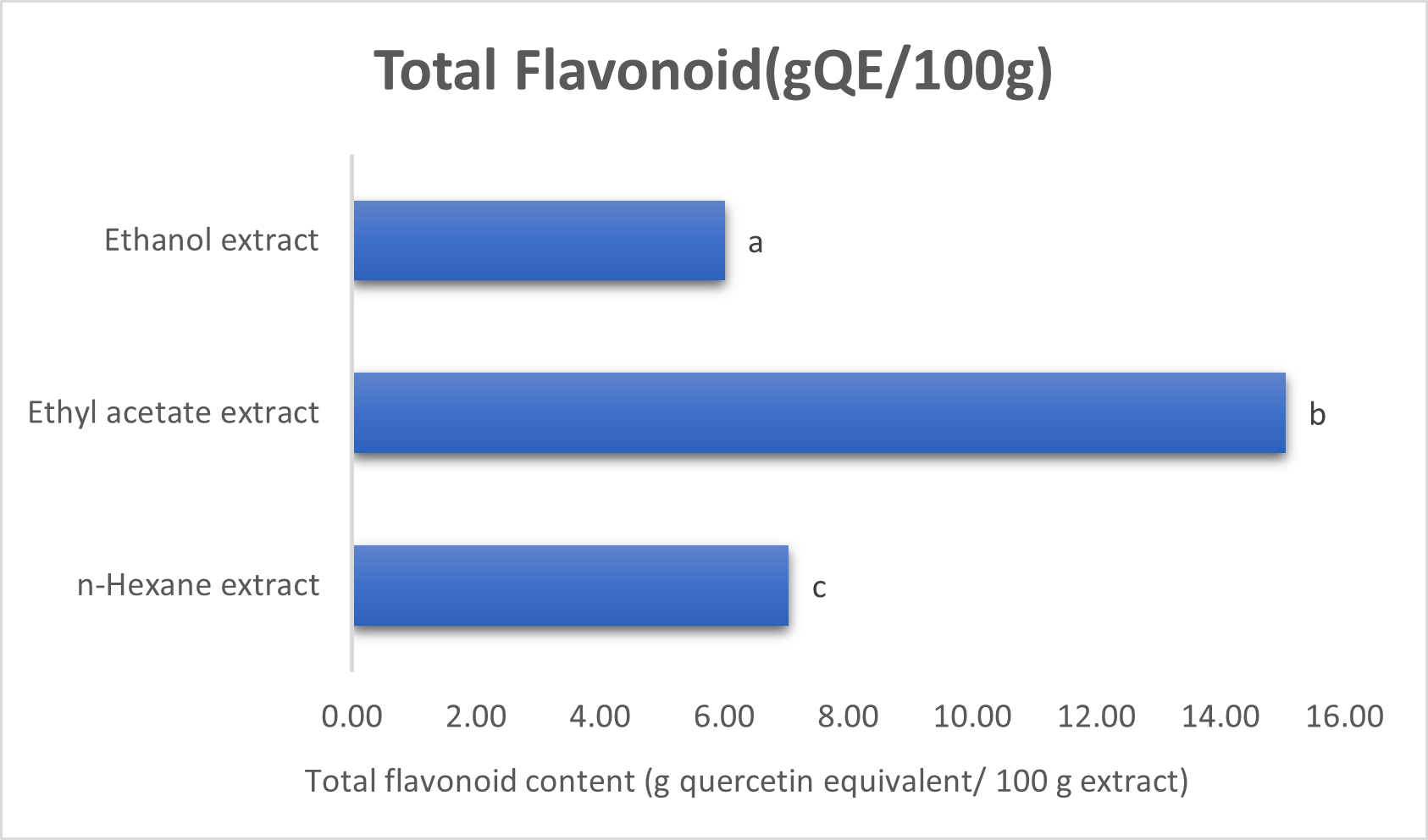Total Flavonoid Content and Antioxidant Activity of Different Polarity Extracts from Pereskia bleo Leaves
DOI:
https://doi.org/10.36733/medicamento.v9i2.6290Keywords:
Antioxidant, DPPH, total flavonoid content, Pereskia bleoAbstract
Antioxidant agents are essential for the body due to its ability to scavenge free radicals. Medicinal plants contain phytochemicals that act as antioxidants. The current research aimed to determine the total flavonoid content (TFC) and antioxidant activity of Pereskia bleo leaves extracts from various solvents with different polarities. The nonpolar solvent (n-hexane) was used as the first step of extraction and its residues were then macerated using semi-polar (ethyl acetate) and polar (ethanol 96%) solvents consecutively. The TFC was determined using the colorimetric method while antioxidant activity was examined through the 2,2-diphenyl-1-picrylhydrazyl (DPPH) method. Antioxidant activity was presented as Inhibitory Concentration 50 (IC50) and Antioxidant Activity Index (AAI). It is noticeable that among analyzed extracts, the ethyl acetate extract of P. bleo leaves contained the highest flavonoid content (15.052 ± 0.172 g quercetin equivalent/100 g extract). Furthermore, the greatest antioxidant activity was obtained from n-hexane extract with the value of IC50 and AAI being 217.307 ppm and 0.230, respectively. Pearson coefficient correlation (r) between TFC and AAI was -0.106. The current study concluded that P. bleo leaves extracts using solvents with different polarities showed variation in TFC values and antioxidant activity. Moreover, TFC was not the main contributor to the antioxidant activity of P. bleo leaves extracts.
References
Zareisedehizadeh S, Tan CH, Koh HL. A review of botanical characteristics, traditional usage, chemical components, pharmacological activities, and safety of Pereskia bleo (Kunth) DC. Evidence-based Complement Altern Med. 2014;2014. doi:10.1155/2014/326107
Nayaka NMDMW, Fidrianny I, Sukrasno, Hartati R, Singgih M. Antioxidant and antibacterial activities of multiflora honey extracts from the Indonesian Apis cerana bee. J Taibah Univ Med Sci. 2020;15(3):211-217. doi:10.1016/j.jtumed.2020.04.005
Liu J-Z, Zhang C-C, Fu Y-J, Cui Q. Comparative analysis of phytochemical profile, antioxidant and anti-inflammatory activity from Hibiscus manihot L. flower. Arab J Chem. 2022;15(1):103503. doi:10.1016/J.ARABJC.2021.103503
Sim KS, Sri Nurestri AM, Norhanom AW. Phenolic content and antioxidant activity of Pereskia grandifolia Haw. (Cactaceae) extracts. Pharmacogn Mag. 2010;6(23):248-254. doi:10.4103/0973-1296.66945
Behnaz Hassanbaglou. Antioxidant activity of different extracts from leaves of Pereskia bleo (Cactaceae). J Med Plants Res. 2012;6(15):2932-2937. doi:10.5897/jmpr11.760
Wahab SIA, Abdul AB, Mohan SM, Al-Zubairi AS, Elhassan MM, Ibrahim MY. Biological activities of Pereskia bleo extracts. Int J Pharmacol. 2009;5(1):71-75. doi:10.3923/ijp.2009.71.75
Johari MA, Khong HY. Total phenolic content and antioxidant and antibacterial activities of Pereskia bleo. Adv Pharmacol Sci. 2019;2019:1-4. doi:10.1155/2019/7428593
Bakhari NA, Abdullah AR, Osman H, Nordin NH. The relationship between phenolic, tannin and flavonoid content with the antioxidant activity of Pereskia bleo (Kunth). CSSR 2010 - 2010 Int Conf Sci Soc Res. Published online 2010:494-498. doi:10.1109/CSSR.2010.5773828
Agada R, Usman WA, Shehu S, Thagariki D. In vitro and in vivo inhibitory effects of Carica papaya seed on α-amylase and α-glucosidase enzymes. Heliyon. 2020;6(3):e03618. doi:10.1016/j.heliyon.2020.e03618
Chang C-C, Yang M-H, Wen H-M, Chern J. Estimation of Total Flavonoid Content in Propolis by Two Complementary Colorimetric Methods. 2002;10(3):178-182.
Scherer R, Godoy HT. Antioxidant activity index (AAI) by the 2,2-diphenyl-1-picrylhydrazyl method. Food Chem. 2009;112(3):654-658. doi:10.1016/j.foodchem.2008.06.026
Fidrianny I, Rezeki EN, Ruslan K, Hartati R, Nayaka NMDMW. The waste products of Mangifera indica L. ‘Arumanis’: In vitro antioxidative activities and phytochemical content. Rasayan J Chem. 2021;14(01):374-381. doi:10.31788/RJC.2021.1415907
Thavamoney N, Sivanadian L, Tee LH, Khoo HE, Prasad KN, Kong KW. Extraction and recovery of phytochemical components and antioxidative properties in fruit parts of Dacryodes rostrata influenced by different solvents. J Food Sci Technol. 2018;55(7):2523. doi:10.1007/S13197-018-3170-6
Thaipong K, Boonprakob U, Crosby K, Cisneros-Zevallos L, Hawkins Byrne D. Comparison of ABTS, DPPH, FRAP, and ORAC assays for estimating antioxidant activity from guava fruit extracts. J Food Compos Anal. 2006;19(6-7):669-675. doi:10.1016/j.jfca.2006.01.003
Othman A, Mukhtar NJ, Ismail NS, Chang SK, Alam S. Phenolics, flavonoids content and antioxidant activities of 4 Malaysian herbal plants. Int Food Res J. 2014;21(2):759-766.
Yan SW, Ramasamy R, Alitheen NBM, Rahmat A. A comparative assessment of nutritional composition, total phenolic, total flavonoid, antioxidant capacity, and antioxidant vitamins of two types of Malaysian underutilized fruits (Averrhoa bilimbi and Averrhoa carambola). Int J Food Prop. 2013;16(6):1231-1244. doi:10.1080/10942912.2011.582975
Shahidi F, Ambigaipalan P. Phenolics and polyphenolics in foods, beverages and spices: Antioxidant activity and health effects – A review. J Funct Foods. 2015;18:820-897. doi:10.1016/J.JFF.2015.06.018
Rice-Evans CA, Miller NJ, Paganga G. Structure-antioxidant activity relationships of flavonoids and phenolic acids. Free Radic Biol Med. 1996;20(7):933-956. doi:10.1016/0891-5849(95)02227-9

Downloads
Published
How to Cite
Issue
Section
License
Copyright (c) 2023 Jurnal Ilmiah Medicamento

This work is licensed under a Creative Commons Attribution-NonCommercial-NoDerivatives 4.0 International License.
The copyright holder for the work is the Jurnal Ilmiah Medicamento.
Jurnal Ilmiah Medicamento is licensed under a Creative Commons Attribution-NonCommercial-NoDerivatives 4.0 International License.
You are free to:
- Share — copy and redistribute the material in any medium or format
- The licensor cannot revoke these freedoms if you follow the license terms.
Under the following terms:
-
Attribution — You must give appropriate credit, provide a link to the license, and indicate if changes were made. You may do so reasonably but not in any way that suggests the licensor endorses you or your use.
-
NonCommercial — You may not use the material for commercial purposes.
-
NoDerivatives — If you remix, transform, or build upon the material, you may not distribute the modified material.
- No additional restrictions — You may not apply legal terms or technological measures that legally restrict others from doing anything the license permits.










